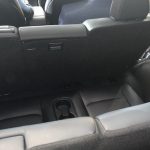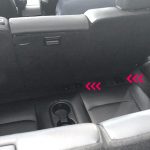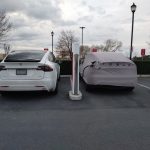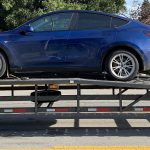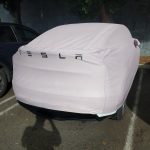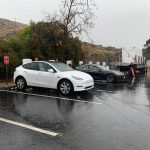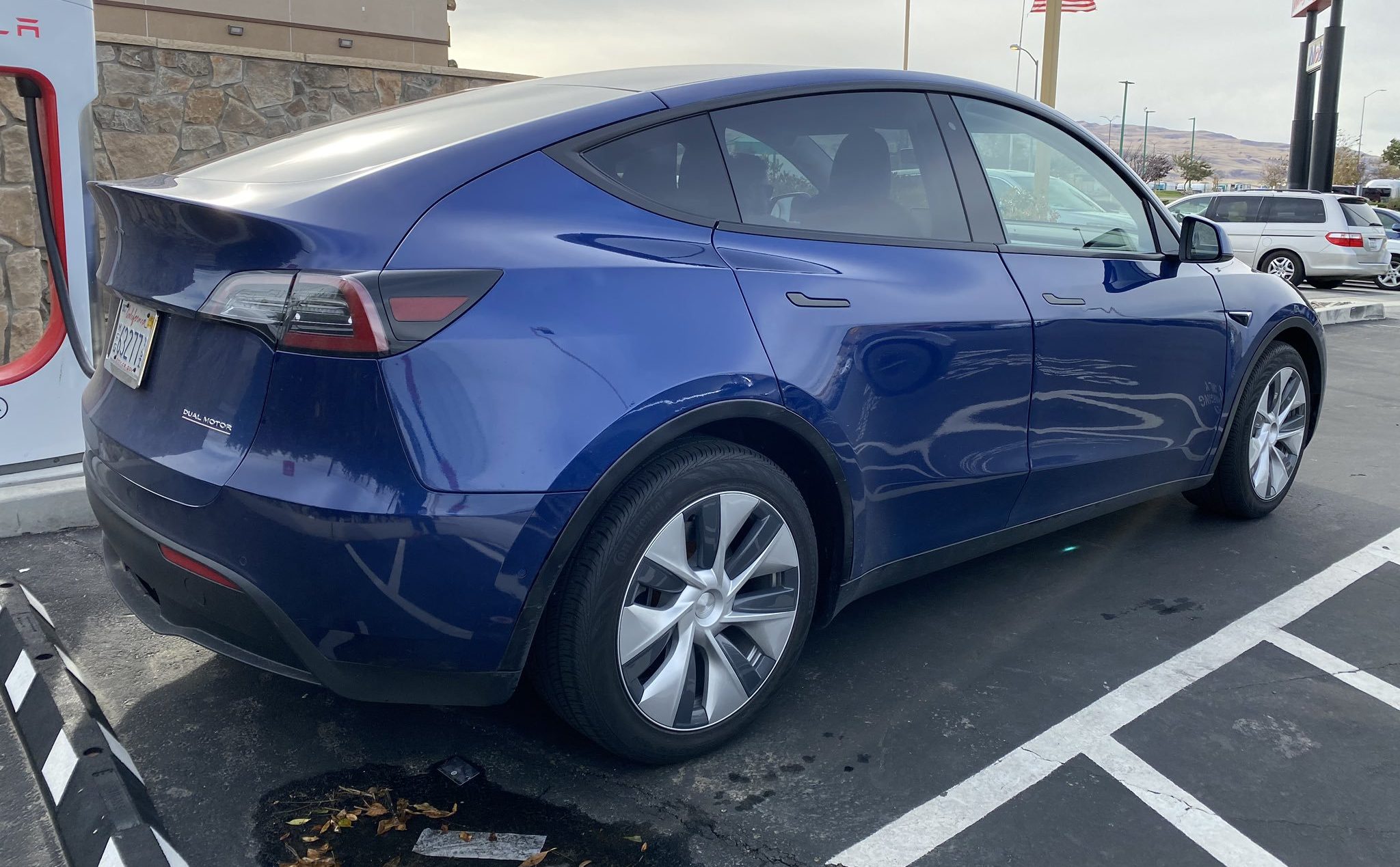
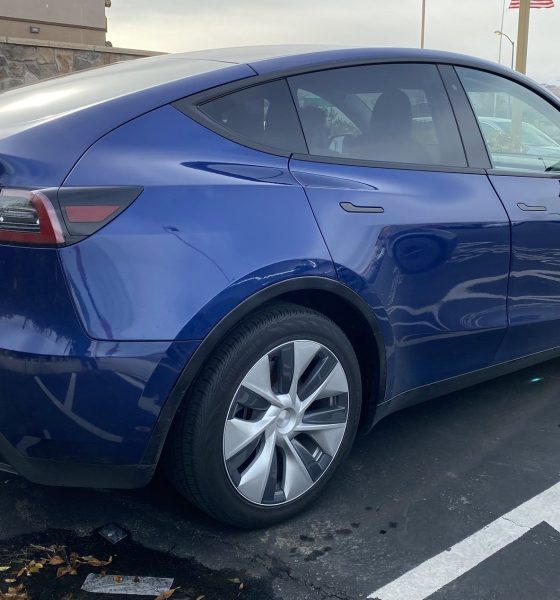
News
Tesla Model Y third-row seats: Latest images show they are not vestigial, provide enough legroom
Tesla Model Y sightings have been whetting the appetite of electric vehicle fans but people are most curious about the third-row seats of the much-awaited electric crossover. New images of the Tesla Model Y third-row seats leaked online and give consumers a good idea of how much space is available.
The latest images of the Model Y third-row seats seems that it will not fit two adults or even two kids since the images show that there’s almost no space between the second and third-row seats. One might think the third-row seats are vestigial but upon closer inspection, there are car seat rails and this means occupants can adjust the second-row seats to give passengers enough room to be comfortable.
- Tesla Model Y Third-Row Seats (Source: News-coffee.com)
- Tesla Model Y Third-Row Seats (Source: News-coffee.com)
These Tesla Model Y interior images show that the upcoming all-electric crossover is a true seven-passenger vehicle with ample space to boot. Aside from having enough legroom, the bulge of the wheel well also suggests there will be enough shoulder room, and the third-row seats of the Model Y positioned just right to have enough head clearance before the rear windshield curves down.
The third-row seats will be Model Y’s X-Factor when it goes on a head-on collision with the BMW X3, Audi Q5, and the Jaguar I-Pace, which are all just five seaters. They can also influence the decisions of potential converts who want to switch from gas-guzzling roomy SUVs to zero-emission vehicles.
Likewise, the latest images may help those pondering a Model Y vs. Model X scenario. A recent sighting of the Model Y next to a Model X revealed that the two vehicles are similar in size. The electric crossover is about 65 inches tall while its SUV sibling is roughly 66 inches tall but the latter is heftier with a width of 78.7 inches when the mirrors are folded. If one is looking for extra seats to carry more passengers or to simply have that third-row factor, the Model Y will be a logical choice that’s worth the money.
The release of the Model Y is getting closer and closer. Aside from the more frequent sightings of the electric crossover in the wild, the California Air Resources Board published its certification recently. For context, when the Model 3’s CARB certificate was published in 2017, Tesla made the first deliveries of the vehicle 25 days after. The CARB certification specific to the Model Y Performance variant gave consumers a hint of the vehicle’s range and hinted that Model Y deliveries are imminent.
The electric crossover will be offered in three variants. The Performance version will go for $61,000 while the Dual Motor All-Wheel Drive Long Range and the Rear-Wheel Drive Long Range will set customers back by $52,000 and $48,000, respectively.
Production of the Model Y will kick off at Tesla’s Fremont factory this Summer. Likewise, CEO Elon Musk formally launched the Model Y program at the carmaker’s Gigafactory 3 in China. The soon to rise Gigafactory 4 in Germany will also produce the all-electric crossover.
- Tesla Model Y next to a Tesla Model X (Source: Anonymous tip via Teslarati)
- Credit: Twitter/jzpchen
- Tesla Model Y spotted in downtown Mountain View CA (Source: u/gamerlike via Reddit)
- Tesla Model Y Performance seen at SLO Supercharger in California (Source: Grant Cassingham)
H/T to u/Subculture1000

Elon Musk
Elon Musk’s X will start using a Tesla-like software update strategy
The initiative seems designed to accelerate updates to the social media platform, while maintaining maximum transparency.

Elon Musk’s social media platform X will adopt a Tesla-esque approach to software updates for its algorithm.
The initiative seems designed to accelerate updates to the social media platform, while maintaining maximum transparency.
X’s updates to its updates
As per Musk in a post on X, the social media company will be making a new algorithm to determine what organic and advertising posts are recommended to users. These updates would then be repeated every four weeks.
“We will make the new 𝕏 algorithm, including all code used to determine what organic and advertising posts are recommended to users, open source in 7 days. This will be repeated every 4 weeks, with comprehensive developer notes, to help you understand what changed,” Musk wrote in his post.
The initiative somewhat mirrors Tesla’s over-the-air update model, where vehicle software is regularly refined and pushed to users with detailed release notes. This should allow users to better understand the details of X’s every update and foster a healthy feedback loop for the social media platform.
xAI and X
X, formerly Twitter, has been acquired by Elon Musk’s artificial intelligence startup, xAI last year. Since then, xAI has seen a rapid rise in valuation. Following the company’s the company’s upsized $20 billion Series E funding round, estimates now suggest that xAI is worth tens about $230 to $235 billion. That’s several times larger than Tesla when Elon Musk received his controversial 2018 CEO Performance Award.
As per xAI, the Series E funding round attracted a diverse group of investors, including Valor Equity Partners, Stepstone Group, Fidelity Management & Research Company, Qatar Investment Authority, MGX, and Baron Capital Group, among others. Strategic partners NVIDIA and Cisco Investments also continued support for building the world’s largest GPU clusters.
News
Tesla FSD Supervised wins MotorTrend’s Best Driver Assistance Award
The decision marks a notable reversal for the publication from prior years, with judges citing major real-world improvements that pushed Tesla’s latest FSD software ahead of every competing ADAS system.

Tesla’s Full Self-Driving (Supervised) system has been named the best driver-assistance technology on the market, earning top honors at the 2026 MotorTrend Best Tech Awards.
The decision marks a notable reversal for the publication from prior years, with judges citing major real-world improvements that pushed Tesla’s latest FSD software ahead of every competing ADAS system. And it wasn’t even close.
MotorTrend reverses course
MotorTrend awarded Tesla FSD (Supervised) its 2026 Best Tech Driver Assistance title after extensive testing of the latest v14 software. The publication acknowledged that it had previously criticized earlier versions of FSD for erratic behavior and near-miss incidents, ultimately favoring rivals such as GM’s Super Cruise in earlier evaluations.
According to MotorTrend, the newest iteration of FSD resolved many of those shortcomings. Testers said v14 showed far smoother behavior in complex urban scenarios, including unprotected left turns, traffic circles, emergency vehicles, and dense city streets. While the system still requires constant driver supervision, judges concluded that no other advanced driver-assistance system currently matches its breadth of capability.
Unlike rival systems that rely on combinations of cameras, radar, lidar, and mapped highways, Tesla’s FSD operates using a camera-only approach and is capable of driving on city streets, rural roads, and freeways. MotorTrend stated that pure utility, the ability to handle nearly all road types, ultimately separated FSD from competitors like Ford BlueCruise, GM Super Cruise, and BMW’s Highway Assistant.
High cost and high capability
MotorTrend also addressed FSD’s pricing, which remains significantly higher than rival systems. Tesla currently charges $8,000 for a one-time purchase or $99 per month for a subscription, compared with far lower upfront and subscription costs from other automakers. The publication noted that the premium is justified given FSD’s unmatched scope and continuous software evolution.
Safety remained a central focus of the evaluation. While testers reported collision-free operation over thousands of miles, they noted ongoing concerns around FSD’s configurable driving modes, including options that allow aggressive driving and speeds beyond posted limits. MotorTrend emphasized that, like all Level 2 systems, FSD still depends on a fully attentive human driver at all times.
Despite those caveats, the publication concluded that Tesla’s rapid software progress fundamentally reshaped the competitive landscape. For drivers seeking the most capable hands-on driver-assistance system available today, MotorTrend concluded Tesla FSD (Supervised) now stands alone at the top.
News
Elon Musk’s Grokipedia surges to 5.6M articles, almost 79% of English Wikipedia
The explosive growth marks a major milestone for the AI-powered online encyclopedia, which was launched by Elon Musk’s xAI just months ago.

Elon Musk’s Grokipedia has grown to an impressive 5,615,201 articles as of today, closing in on 79% of the English Wikipedia’s current total of 7,119,376 articles.
The explosive growth marks a major milestone for the AI-powered online encyclopedia, which was launched by Elon Musk’s xAI just months ago. Needless to say, it would only be a matter of time before Grokipedia exceeds English Wikipedia in sheer volume.
Grokipedia’s rapid growth
xAI’s vision for Grokipedia emphasizes neutrality, while Grok’s reasoning capabilities allow for fast drafting and fact-checking. When Elon Musk announced the initiative in late September 2025, he noted that Grokipedia would be an improvement to Wikipedia because it would be designed to avoid bias.
At the time, Musk noted that Grokipedia “is a necessary step towards the xAI goal of understanding the Universe.”
Grokipedia was launched in late October, and while xAI was careful to list it only as Version 0.1 at the time, the online encyclopedia immediately earned praise. Wikipedia co-founder Larry Sanger highlighted the project’s innovative approach, noting how it leverages AI to fill knowledge gaps and enable rapid updates. Netizens also observed how Grokipedia tends to present articles in a more objective manner compared to Wikipedia, which is edited by humans.
Elon Musk’s ambitious plans
With 5,615,201 total articles, Grokipedia has now grown to almost 79% of English Wikipedia’s article base. This is incredibly quick, though Grokipedia remains text-only for now. xAI, for its part, has now updated the online encyclopedia’s iteration to v0.2.
Elon Musk has shared bold ideas for Grokipedia, including sending a record of the entire knowledge base to space as part of xAI’s mission to preserve and expand human understanding. At some point, Musk stated that Grokipedia will be renamed to Encyclopedia Galactica, and it will be sent to the cosmos.
“When Grokipedia is good enough (long way to go), we will change the name to Encyclopedia Galactica. It will be an open source distillation of all knowledge, including audio, images and video. Join xAI to help build the sci-fi version of the Library of Alexandria!” Musk wrote, adding in a later post that “Copies will be etched in stone and sent to the Moon, Mars and beyond. This time, it will not be lost.”
